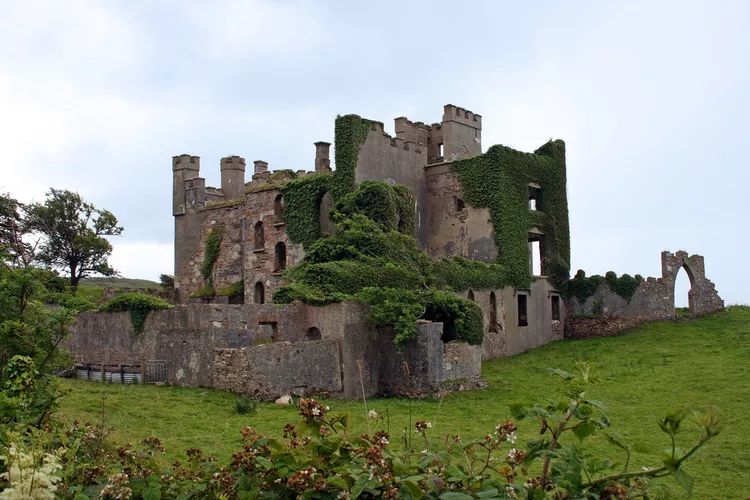Summary
- History: Explore the intriguing past of Clifden Castle, built by John D’Arcy in the early 1800s.
- What to See: Discover the distinctive features of the castle ruins and the surrounding scenic landscape.
- How to Visit: Learn how to access Clifden Castle and the essential details for your visit.
- What Else to Do Nearby: Engage with the local culture by visiting nearby attractions, including museums and historical sites.
History
Clifden Castle is a ruined manor house that was once the stately home of John D’Arcy. D’Arcy founded the nearby town of Clifden and constructed the castle for his family in the early 1800s. The wealthy landowner had the castle designed in a Gothic Revival style, featuring mock turrets. The land surrounding the castle was leased to impoverished tenants, and the rents contributed to the D’Arcy family’s upkeep in Clifden Castle for two generations.
Following John D’Arcy’s death in 1839, he bequeathed the castle to his eldest son. Unfortunately, this son had taken out a mortgage on the property earlier, and his successor, Hyacinth D’Arcy, lacked the estate management skills his father possessed.
With the onset of the potato crop failure and ensuing famine in 1845, the family’s rental income plummeted to practically nothing. In 1846, starving tenants protested in front of the castle, demanding food. By 1850, the D’Arcy family had declared bankruptcy, leading to Clifden Castle’s sale to the Eyre family.
The Eyres utilized the castle as a vacation retreat until the head of the family passed away in 1894. The property was left unvisited afterward, causing the castle to fall into disrepair. Although the farmland around the manor continued to be leased, no one has resided within the castle since the late 19th century.
A local butcher acquired the castle and the land in 1917. Subsequently, farmers leasing the adjacent lands brought forth a legal challenge, asserting the illegitimacy of the land sale. In 1921, a cooperative of farmers was formed to take collective ownership of the estate, and it has remained under joint ownership ever since.
The castle is still owned by the Clifden Cooperative but has been left abandoned to the elements.
What to See
The ownership dispute surrounding Clifden Castle centered more on the farmland than the stunning stone structure itself. Consequently, the castle is now a roofless ruin, exposed to the changing weather.
All interior furnishings were auctioned long ago, and someone eventually stripped the building of any remaining valuable timber and glass. Nevertheless, most of the exterior walls still stand tall, providing a glimpse into what the manor may have looked like in the 19th century.
One unique feature includes a series of standing stones that John D’Arcy placed leading up to the home, which were intended to mimic the ancient stone pillars found throughout Ireland. While many of these large stones bear markings from the Bronze Age, the Clifden stones likely originate from the 18th century.
The walk towards the ruins offers spectacular views of the Connemara countryside, likely dotted with grazing cows and sheep. The castle itself overlooks Clifden Bay, offering a picturesque backdrop for photography.
How to Visit
Clifden Castle is situated just outside the town of Clifden in the Connemara region of County Galway. Accessing the castle requires a pleasant walk along a dirt track. Leaving Clifden, drive just over a mile (2 kilometers) until you encounter the arched gateway. Although parking is limited, you can find spaces along the road. Follow the unpaved path that descends downhill for a rewarding view of the ruins and the sparkling Clifden Bay.
Although the castle is on private property, the pathway remains open for visits. There are no guided tours or defined opening hours, so visitors can explore at their convenience. However, caution is advised due to the questionable state of the walls. While it’s possible to walk through the ruins, safety should be a priority.
What Else to Do Nearby
The Station House Museum is a small establishment dedicated to the railroad’s history in the area. Housed in a quaint building that once served as the local station, it introduces visitors to the significance of ponies and the initial transatlantic wireless messages that were sent nearby.
Consider taking a stroll through the bogland to reach Derrigimlagh Discovery Point, where Guglielmo Marconi established the radio towers that transmitted the first wireless message across the Atlantic Ocean in 1907. This site is also notable as the landing spot of aviators John Alcock and Arthur Brown following their historic transatlantic flight in 1919.
If you visit Clifden in August, be sure to attend the Connemara Pony Festival, a historic horse show that was founded nearly a century ago to preserve the local pony breed. Various pony shows and parades are held in spring and around Christmas. More details on events can be found through the breeder’s society.
Omey Island, located to the north of Clifden, is a charming rural island accessible at low tide. Here, you will find a small medieval church and a revered spot known as Saint Feichin’s well.





